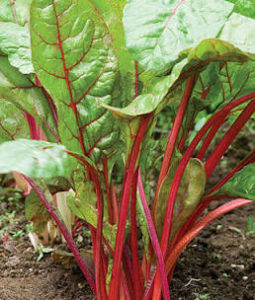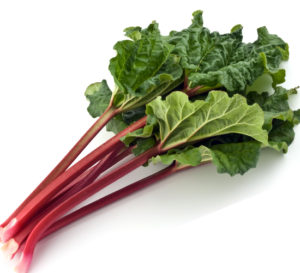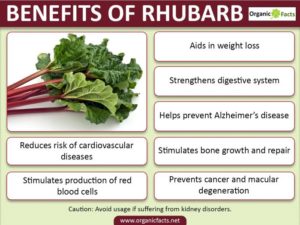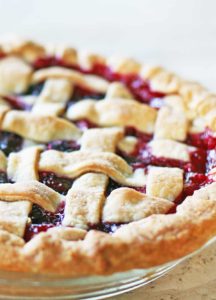
TODAY’S LESSON: Rhubarb loves the cool spring growing season that develops the stalks slowly and full of flavor. Today we will unlock the secrets to a perfect rhubarb pie.
WHERE DOES RHUBARB COME FROM? The early origins of rhubarb can be traced to northern Asia. It was first heard of in ancient China around 2700 B.C. where it was used for medicinal purposes for nearly four and a half millennia and not for consumption as a food source. The root of the rhubarb was used as a purgative utilized to cleanse the body of disease. Rhubarb reached the Western world around the beginning of the Christian era. How it traveled from Asia to find its way to the Mediterranean at a time when the Greeks or Romans were unaware of the existence of Asia or its inhabitants is very intriguing. We gain a little history when we determine the whereabouts of rhubarb by deciphering its name. The name “rhubarb” comes from the Latin Rhabarbarum, translated “Rha of the barbarians”. Rha is the ancient name of the river on which the barbarians cultivated rhubarb. Today, we know the Rha as the Volga River.
Rhubarb is touched only lightly as a food in history. Marco Polo made reference that it was exported far and wide from China. From the time of the Middle Ages, rhubarb made its way into European apothecaries as a medicine and was later found growing in the gardens surrounding monasteries. In the Western world, it had not occurred to anyone that it might be edible. When this idea did occur, they mistakenly ate the wrong part…the leaves. The leaves should never be eaten as they contain “oxalic acid”, a toxic substance which is not meant for human consumption. The unfortunate discovery in the seventeenth century of the toxicity of the rhubarb leaves definitely delayed its acceptance as a food source. Rhubarb appeared in America following the Revolutionary War. It wasn’t until nearly the eighteenth century and beyond that, the unusual taste of the stalk was considered by some extraordinary and pleasing to the palate of those who relished its tartness.
WHAT EXACTLY IS RHUBARB? Rhubarb or “pieplant” is a perennial plant (Rheum rhaponticum) with long pink to red celery like stalks and large green leaves that are toxic. The stalks of the rhubarb plant are extremely tart in flavor. Quite often in baking to compliment the sweet flavor of such fruit as strawberries, raspberries and the like. Rhubarb loves cool spring weather which brings the tender stalks to maturity. Grown from seed, rhubarb will take three springs to reach full foliage and hearty production which will last approximately 10 years. The stalks emerge from root bases called crowns or corms and are best harvested when 12-18 inches in height. Only half of the stalks should be harvested each year allowing the remainder to regenerate the roots for the next year’s production.

SELECTING YOUR RHUBARB: Look for rhubarb that is crisp and plump with crisp looking red or pink medium-size stalks with leaves still attached. Avoid rhubarb that is wilted, has blemishes or that is pale in color. Rhubarb can be stored wrapped in your refrigerator for a few days if necessary.
PREPARING YOUR RHUBARB: Rhubarb should be cleaned of all leaves and a fresh cut made at the stem line. Rinse under cold running water and remove all blemishes from the stems. Pat dry with paper towel. Cut into desired size or dice as your recipe recommends.
TRICKS OF THE TRADE: The sugaring of the rhubarb draws out the moisture from the stalks, thus softening when baked. Without adding the sugar the stalks would remain quite firm.
THE COOKING BEGINS: The traditional method of cooking rhubarb is to coat it with sugar and spices and bake it in a pie or flan. The oven cooking tenderizes the rhubarb while developing the natural gelatinous texture of the pulp for the pie filling. First combine the dry ingredients of sugar and flour, then mix in the butter and eggs to moisten. Add the rhubarb and ginger tossing to coat all the surfaces. Transfer to a pie shell. Top with additional pastry woven into a lattice pattern. Bake for 10 minutes at 425 degrees to start the crust browning then turn down to 350 degrees to cook the rhubarb until tender, about 30 minutes or so. Remove to cool to allow the pie texture to set up.

ADVANTAGES: Rhubarb is quite nutritious with dietary fiber, protein, vitamins K, C and B Complex. It is rich in calcium, lutein, potassium, and magnesium. Rhubarb packs lots of beneficial antioxidants
SERVING SUGGESTIONS: Rhubarb likes stronger spice flavors. Ginger is one of my favorites but so is nutmeg, cinnamon and more. The creamy taste of ice cream cuts some of the sharp strong tomes of the rhubarb.
TRY YOUR TECHNIQUE: Try this fabulous tart or if you prefer you can put it in a traditional pie shell, but don’t miss a classic Rhubarb and Ginger Pie.

RHUBARB and GINGER PIE
Makes one 10 inch tart or pie
1-3/4 cup superfine sugar
3 tablespoons all-purpose flour
1 teaspoon grated nutmeg
2 tablespoons unsalted butter, cut up
2 large eggs, beaten
4 cups rhubarb, cut into 1-inch pieces
1/4 cup minced stem ginger, preserved in sugar syrup
1 pastry lined 10-inch tart or pie shell (recipe follows)
1 egg yolk
1/4 cup half-and-half cream
2 tablespoons of coarse or turbinado sugar
1-quart vanilla ice cream
Confectioner’s sugar for garnish
Mint sprigs for garnish
Preheat your oven to 425 degrees F.
In a large bowl combine the sugar, flour, and nutmeg. Mix in the butter and the eggs until the dry ingredients are moistened. Add the rhubarb and ginger tossing to thoroughly coat. Transfer into a pastry lined pie shell. Cover with the top lattice pastry and crimp the edges. Brush the pastry with a mixture of egg yolk and 1/4 cup of cream. Sprinkle with the coarse or turbinado sugar.
Place on the lower rack of the oven. Cook until the crust just begins to brown, about 10 minutes. Turn the oven temperature down to 350 degrees and bake until the rhubarb is tender as checked by inserting a skewer into a couple of the pieces through the openings in the pastry, about 30 minutes or so. Remove from the oven and allow to cool on a cake rack to room temperature.
Serve a wedge of pie with ice cream. Garnish with a dusting of confectioner’s sugar and a sprig of mint.
PIE PASTRY
Makes 1 pie
3 cups all-purpose flour, sifted
1 teaspoon salt
1-1/3 cup vegetable shortening
1 egg, beaten
1 tablespoon vinegar
5 tablespoons ice water
In a large bowl sift together the flour and the salt. Add the shortening and cut into the flour. Make a well and slowly mix in the egg with a fork. In another bowl, combine the vinegar and the water. Add the liquid just until the pastry combines. Remove the pastry to a parchment lined cookie sheet and flatten the dough into a rectangle. Cover with plastic wrap and refrigerate for at least 30 minutes. To roll remove the dough from the refrigerator and place on a flour dusted, cool countertop. Roll the dough to 1/4 inch thick and cut to your desired pie shell. Roll the remainder and cut into strips to weave for a lattice topping or artistic shapes to decorate the center of the tart.
Proceed with your pie recipe.
Jimmy Schmidt